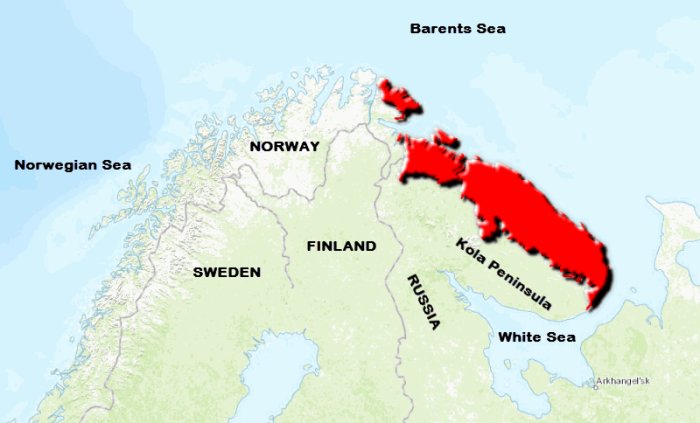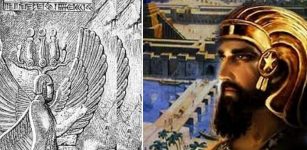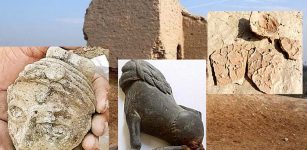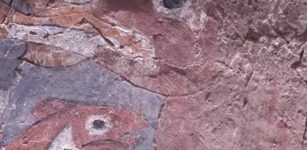Mysterious Kola Pyramids Built By An Unknown Lost Ancient Civilization Can Rewrite Ancient History
Ellen Lloyd - AncientPages.com - Ancient Egyptian pyramids are magnificent and worthy of admiration. Egypt can be proud of all its beautiful ancient monuments, tombs, statues, and countless other artifacts that add glory to the country's' enigmatic and fascinating ancient history.
The same can be said about the pyramids raised in Mesoamerica, Mesopotamia, and all other places where we encounter ancient pyramidal structures.

It's' well-known that almost every ancient culture left a legacy that was marked by towering pyramids.
Still, whenever you mention pyramids, most people think about Egypt, and it's' not surprising because they are the most famed ones. But did you know many similar structures pre-date the Egyptian civilization? Not all of them are as famous, but they are equally interesting and deserve further scientific investigation.
Were The Kola Pyramids Built By The Hyperboreans?
In the Kola peninsula, archaeologists have examined fascinating pyramids that can rewrite ancient history. The pyramids are estimated to be approximately 9,000-year-old and pre-date the Egyptian ones.
The first know study of the Kola pyramids took place in the early 1920s when Russian researcher Alexander Vasilyevich Barchenko (1881 – 1938) traveled with a scientific team to investigate the mysterious, unknown ancient structures. Barchenko was not a mainstream scientist, and his theories are controversial but very interesting.
Barchenko became convinced the Kola pyramids were constructed by the lost civilization of Hyperborea, a mythical island according to ancient Greeks.
Hecataeus of Miletus (550 B.C - 476 B.C), the first known Greek historian, came to believe the holy place of the Hyperboreans lay "on an island in the ocean…beyond the land of the Celts."
According to Diodorus Siculus (90 B.C. – 30 B.C), who was also a Greek historian God Apollo regularly visited the mysterious land of Hyperborea on his swan-drawn chariot.

Credit: Public Domain
Diodorus wrote, "Opposite to the coast of Celtic Gaul there is an island in the ocean, not smaller than Sicily, lying to the North—which is inhabited by the Hyperboreans, who are so named because they dwell beyond the North Wind. This island is of a happy temperature, rich in soil and fruitful in everything, yielding its produce twice in the year.
Tradition says that Latona was born there, and for that reason, the inhabitants venerate Apollo more than any other God. They are, in a manner, his priests, for they daily celebrate him with continual songs of praise and pay him abundant honors.

Photo from Barchenko's expedition to the Kola Peninsula in 1922. Credit: RBTH.
On this island, there is a magnificent grove of Apollo, and a remarkable temple, of a round form, adorned with many consecrated gifts. There is also a city, sacred to the same God, most of the inhabitants of which are harpers, who continually play upon their harps in the temple, and sing hymns to the God, extolling his actions. The Hyperboreans use a peculiar dialect, and have a remarkable attachment to the Greeks, especially to the Athenians and the Delians…"
"It is also said that in this island the moon appears very near to the earth, that certain eminences of a terrestrial form are plainly seen in it, that Apollo visits the island once in a course of nineteen years, in which period the stars complete their revolutions, and that for this reason, the Greeks distinguish the cycle of nineteen years by the name of ""the great year""…"
Hyperborea has never been found, but it doesn't' necessarily mean the place never existed. Submerged ancient ruins of Hyperborea may still be discovered.
Could the abandoned Kola Pyramids of the Russian North have been a legacy of a lost, advanced ancient civilization we know virtually nothing about?

Kola pyramids. Credit: Good Hotels Russia
Barchenko's' theory was that humans emerged from the northern regions during the Golden Age, about 12 thousand years ago. A great flood forced Aryan tribes living there to leave the area to move originated in the North in the era of the so-called Golden Age, that is, about 10-12 thousand years ago. The Flood caused the Aryan tribes living there to leave the Kola Peninsula and move south.

Alexander Vasilyevich Barchenko in 1937 one year before he was executed. Credit: Public Domain
After having studied Masonic literature, the late Russian scientist became convinced the Hyperboreans were a very advanced civilization that mastered atomic energy, levitation, and flight. He also believed that Sami shamans who lived on the Kola Peninsula were the carriers of the ancient knowledge of Hyperborea.
Bashenko was a vivid student of religious and mystical subjects. Though his theories have never been confirmed they are of great interest to students of alternative ancient history.
Bashenko was executed in Moscow during the Great Purge on April 25, 1938.
Unknown Voids And Chambers Inside Kola Pyramids
In 2007, a Russian expedition team made an attempt to study the pyramids. Among these scientists were the press secretary of the Pulkovo Observatory, candidate of physical and mathematical sciences Sergey Smirnov, Professor of the Russian Academy of Natural Sciences Valery Chudinov, and professor, doctor of geological and geographical sciences Dmitry Subetto.
It was a more dangerous and challenging journey than the researchers had expected. The Kola pyramids are located in a remote region and the locals, the Lapps, were reluctant to show the way.

Many of the stones in the vicinity appear to be man-made. Credit: Zizu Hotel Russia
According to one of the team members, Russian scientists observed the pyramids from a helicopter, but not all structures were visible from the air due to dense vegetation.
Their helicopter almost crashed, but they did eventually manage to reach the ancient site and study these enigmatic structures. According to the Russian geologists, the Kola pyramids are two buildings about 50 meters high, connected by a bridge, and oriented to the cardinal points.
"During the expedition, we took a special instrument, the most modern geophysical equipment - the Oko georadar,"" one of the researchers said.
The tool "shines through" the inner space of any object, like an x-ray. The conclusion of the geologists was unequivocal: the elevations are anthropogenic in nature; therefore, these are not natural hills, but man-made pyramids - the work of human hands. There are voids and unknown chambers inside the pyramids.
The function and purpose of the Russian pyramids remain unknown. Perhaps they were used as an astronomical observatory in ancient times. What is known is that they are much older than the Egyptian pyramids and their existence offers yet a new exciting chapter we can add to our history books.
It's' fair to say that mystery of the Kola pyramid remains unsolved to this day.
Updated on February 12, 2022
Written by Ellen Lloyd – AncientPages.com
Copyright © AncientPages.com All rights reserved. This material may not be published, broadcast, rewritten or redistributed in whole or part without the express written permission of AncientPages.com
More From Ancient Pages
-
 Mysterious Ancient Mushrooms In Myths And Legends: Sacred, Feared And Worshiped Among Ancient Civilizations
Featured Stories | Apr 26, 2023
Mysterious Ancient Mushrooms In Myths And Legends: Sacred, Feared And Worshiped Among Ancient Civilizations
Featured Stories | Apr 26, 2023 -
 Secret Writing On Mummy Papyrus Revealed – Scan Technique Will Shed Light On Daily Life In Ancient Egypt
Archaeology | Jan 1, 2018
Secret Writing On Mummy Papyrus Revealed – Scan Technique Will Shed Light On Daily Life In Ancient Egypt
Archaeology | Jan 1, 2018 -
 Jörmungandr – Hideous Poison-Spewing Midgard Serpent Was One Of Loki’s Children
Featured Stories | Mar 31, 2018
Jörmungandr – Hideous Poison-Spewing Midgard Serpent Was One Of Loki’s Children
Featured Stories | Mar 31, 2018 -
 Seven Bronze Age Swords And Large Hoard Of Slavic Coins Found In Germany
Archaeology | Dec 4, 2023
Seven Bronze Age Swords And Large Hoard Of Slavic Coins Found In Germany
Archaeology | Dec 4, 2023 -
 Megaliths In Central France: 30 Prehistoric Monolith Stones And One Human Skeleton – Unearthed
Archaeology | Sep 11, 2019
Megaliths In Central France: 30 Prehistoric Monolith Stones And One Human Skeleton – Unearthed
Archaeology | Sep 11, 2019 -
 Cyrus The Great: Founder Of Achaemenid Empire Who Conquered Medians, Lydians And Babylonians
Featured Stories | Mar 21, 2019
Cyrus The Great: Founder Of Achaemenid Empire Who Conquered Medians, Lydians And Babylonians
Featured Stories | Mar 21, 2019 -
 Dead City Of Serjilla – Byzantine Village In Syria Struggling To Survive The Middle Of A War Zone
Featured Stories | Jan 27, 2020
Dead City Of Serjilla – Byzantine Village In Syria Struggling To Survive The Middle Of A War Zone
Featured Stories | Jan 27, 2020 -
 Human Activities In The Year 1300 Impacted Earth’s Atmosphere More Than Previously Known
Archaeology | Oct 9, 2021
Human Activities In The Year 1300 Impacted Earth’s Atmosphere More Than Previously Known
Archaeology | Oct 9, 2021 -
 Why Did Vikings Carry Decorative Swords That Were Useless In Combat?
Ancient History Facts | Jun 8, 2024
Why Did Vikings Carry Decorative Swords That Were Useless In Combat?
Ancient History Facts | Jun 8, 2024 -
 Eclipse Was A Bad Omen, A Sign Of Gloom And Doom In Ancient Peoples’ Beliefs
Featured Stories | Sep 25, 2015
Eclipse Was A Bad Omen, A Sign Of Gloom And Doom In Ancient Peoples’ Beliefs
Featured Stories | Sep 25, 2015 -
 Early Expansion Of Homo sapiens: Underwater Caves Give New Clues About Sicily’s First Residents
Underwater Discoveries | Oct 15, 2024
Early Expansion Of Homo sapiens: Underwater Caves Give New Clues About Sicily’s First Residents
Underwater Discoveries | Oct 15, 2024 -
 Ming-Era Two Shipwrecks With 100,000 Ancient Relics Examined By Scientists
Archaeology | May 30, 2023
Ming-Era Two Shipwrecks With 100,000 Ancient Relics Examined By Scientists
Archaeology | May 30, 2023 -
 On This Day In History: Famous American Author Edgar Allan Poe Found Dying – On Oct 3, 1849
News | Oct 3, 2016
On This Day In History: Famous American Author Edgar Allan Poe Found Dying – On Oct 3, 1849
News | Oct 3, 2016 -
 3,400-Year-Old Cuneiform Tablet Excavated In Old City Of Alalah
Archaeology | Aug 23, 2020
3,400-Year-Old Cuneiform Tablet Excavated In Old City Of Alalah
Archaeology | Aug 23, 2020 -
 The Helm Of Awe – Powerful Viking Symbol For Physical, Mental And Spiritual Protection
Ancient Symbols | May 25, 2018
The Helm Of Awe – Powerful Viking Symbol For Physical, Mental And Spiritual Protection
Ancient Symbols | May 25, 2018 -
 Buddhist ‘Dillu Roy’ Resembles Mohenjo Daro And Harappa And Now Unveils Its Ancient Secrets
Archaeology | Aug 25, 2020
Buddhist ‘Dillu Roy’ Resembles Mohenjo Daro And Harappa And Now Unveils Its Ancient Secrets
Archaeology | Aug 25, 2020 -
 The Green Knight – New Movie Based On Arthurian Legend
Myths & Legends | Aug 7, 2021
The Green Knight – New Movie Based On Arthurian Legend
Myths & Legends | Aug 7, 2021 -
 Horrifying Flying Head That Terrorized The Iroquois
Featured Stories | Sep 17, 2019
Horrifying Flying Head That Terrorized The Iroquois
Featured Stories | Sep 17, 2019 -
 DNA Study Of Controversial Ancient North American Mummies, Including The Spirit Cave Mummy Opens An Extraordinary Chapter In Human History
Archaeology | Nov 15, 2018
DNA Study Of Controversial Ancient North American Mummies, Including The Spirit Cave Mummy Opens An Extraordinary Chapter In Human History
Archaeology | Nov 15, 2018 -
 1,700-Year-Old Moche Culture Ceremonial Banquet Hall Discovered In Peru
Archaeology | Jan 12, 2018
1,700-Year-Old Moche Culture Ceremonial Banquet Hall Discovered In Peru
Archaeology | Jan 12, 2018
